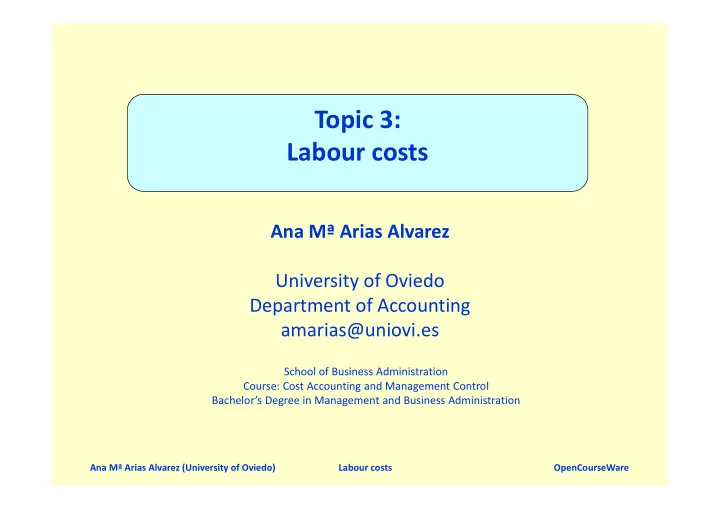

Topic 3: Labour costs Ana Mª Arias Alvarez University of Oviedo Department of Accounting amarias@uniovi.es School of Business Administration Course: Cost Accounting and Management Control Bachelor’s Degree in Management and Business Administration Ana Mª Arias Alvarez (University of Oviedo) Labour costs OpenCourseWare
3.1. Labour costs and their components. 3.2. Labour cost accounting. 3.3. Incentive compensation plans. 2/8 Ana Mª Arias Alvarez (University of Oviedo) Labour costs OpenCourseWare
3.1: LABOUR COSTS AND THEIR COMPONENTS. Labour costs are those costs incurred by the employer in the employment of labour. Components of labour costs: A) Payroll: Remuneration for work performed. Employer’s National Insurance contribution. Miscellaneous items: - Transport of workers. - Work clothing, contributions to pension funds, etc. B) Recruitment and layoffs. 3/8 Ana Mª Arias Alvarez (University of Oviedo) Labour costs OpenCourseWare
3.2: LABOUR COST ACCOUNTING. ATTENDANCE TIME: It is established by time clocks. WORKING TIME: The time that employees actually work. It is determined by: • Time sheets. • Job cards. IDLE TIME: Attendance time – working time. Treatment: Normal and controllable idle time: when responsibilities can be identified with a particular order, idle time should be charged to that order. Normal and uncontrollable idle time: the wage rate of employees gets inflated due to idle time. Abnormal and uncontrollable idle time: period costs (inefficiencies). 4/8 Ana Mª Arias Alvarez (University of Oviedo) Labour costs OpenCourseWare
3.3: INCENTIVE COMPENSATION PLANS. They are adopted for these reasons: - Employees: they have an opportunity to earn additional pay by performing at a more efficient level. - Company: to reduce the cost per unit of finished products. Although wages will increase because of the compensation plan, fixed costs will not increase, thus the fixed cost per unit will decrease after spreading the same fixed costs over a higher production level. 5/8 Ana Mª Arias Alvarez (University of Oviedo) Labour costs OpenCourseWare
BEFORE THE INTRODUCTION OF THE COMPENSATION PLAN: 600 units (8 hours) DIRECT UNITS LABOUR FIXED COSTS PER UNIT PRODUCED COSTS COSTS LABOUR FIXED TOTAL 600 units (8 hours) € 180 € 120 €0.30 €0.2 €0.50 AFTER THE INTRODUCTION OF THE COMPENSATION PLAN: 750 units (8 hours) Time which has been saved: 2 hours. If the company pays the value of the time saved by the employee: 2 hours x €180 / 8 hours = € 45 DIRECT LABOUR FIXED COSTS PER UNIT PRODUCTION COSTS COSTS LABOUR FIXED TOTAL 180 + 45 = 750 units €225 €120 €0.30 €0.16 €0.46 6/8 Ana Mª Arias Alvarez (University of Oviedo) Labour costs OpenCourseWare
Alternative way to calculate the premium to be paid if the company pays the value of the time saved by the employee: As labour cost per unit remains the same: 180 Premium €0.30 per unit = 750 units Premium = € 45 7/8 Ana Mª Arias Alvarez (University of Oviedo) Labour costs OpenCourseWare
Task: try to solve problem 3.1. 8/8 Ana Mª Arias Alvarez (University of Oviedo) Labour costs OpenCourseWare
Recommend
More recommend